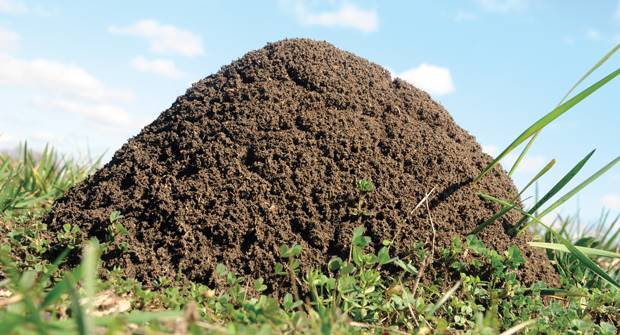
One of the most iconic insect pests in the U.S., red imported fire ants can be a nightmare for lawn care operators (LCOs).
The fire ant has established itself nationwide, but is particularly an issue in the southeast, according to Bobby Kerr, technical service manager for Quali-Pro.

“These ants will usually have reddish to brown heads and bodies that transition to darker, almost black abdomens,” says Kerr. “Another identifying feature, if you choose to examine them closely, will be the two nodes, or bumps, located on their thin waist just before the large abdomen.”
Burn baby, burn
While fire ants don’t damage turf, their mounds can damage equipment. However, the biggest issue that fire ants present to both LCOs and homeowners is that they can be aggressive if disturbed and pack a painful sting.
If provoked, fire ants swarm and latch onto the skin of their target. After they’ve stung and been brushed off, the person or animal they stung is left with burning and swelling.
Another issue, Kerr adds, is that ants will make their way into buildings and other structures while foraging for food. This, he says, makes fire ants something that homeowners will likely want taken care of immediately after they’ve been spotted on their property.
Spotting mounds
Fire ants are easy to spot if you know what to look for, specifically their unique mounds. Fire ant mounds are large and usually flat, with no visual entrances. In certain situations, undisturbed fire ant mounds can reach up to 18 inches in height — but on a lawn, they will be much smaller.
“Mounds can be found throughout a property,” Kerr says. “Most commonly, mounds will be found on areas of the home lawn and ornamental beds. Fire ants thrive in disturbed habitats, including yards, gardens, alongside curbs or sidewalks and in grassy areas.”
While also being an eyesore, fire ant mounds can damage a lawn care operator’s equipment if they are also providing maintenance.
“The mounds are more of a nuisance when mowing or performing other cultural practices. Mower blades will dull quicker and need more frequent sharpening,” Kerr says.
Treatment options
Several treatment options exist for LCOs with a fire ant infestation on a property they manage, according to Kerr.
“Granular insecticides, liquid concentrates and bait granules are all important tools for ant management, and the speed and length of control can depend on the product you choose,” he says. “If curative action and quick results are needed, especially in places with high foot traffic, a contact insecticide spray product is a good option to consider. Targeting mounds with products that can be used for mound drenching, like bifenthrin, is also an effective approach for fire ant control.”
Kerr also recommends broadcast bait applications as an effective option for control. LCOs that choose broadcast bait will spread the granular product across an area for foraging fire ants to find and take it to the colony, where it is shared among nest mates and the queen.
Another potential method is individually treating mounds. This can be an effective strategy for LCOs with just a few mounds on their property, but Kerr adds that these treatments only control the mound where the application is applied and will not affect other mounds in an area.
Application timing is crucial for control —specifically with broadcast bait applications according to Kerr. He recommends that LCOs start to make bait available on a customer’s lawn as temperatures start to rise in the spring.
“(This is when) mounds appear, and workers actively forage for food,” he says. “Another effective strategy involves bait applications in the fall, as it targets colonies when they are in decline. This approach helps to reduce the population and mounds the following spring.”


